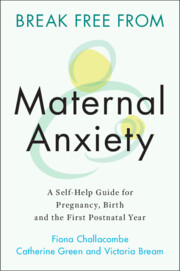 Break Free from Maternal Anxiety
Break Free from Maternal Anxiety Book contents
- Reviews
- Break Free from Maternal Anxiety
- Break Free from Maternal Anxiety
- Copyright page
- Dedication
- Contents
- About the Authors
- How to Use This Book
- Acknowledgements
- 1 Introduction
- 2 Persistent and Distressing Worry
- 3 Unwanted Intrusive Thoughts of Harm (Obsessive Compulsive Disorder)
- 4 Specific Phobias Affecting Pregnancy and the Postnatal Period
- 5 Panic Attacks and Health Worries
- 6 Feeling Anxious Around Other People
- 7 Coping with Traumatic Experiences While Pregnant and After Birth
- 8 Anxiety About Pregnancy and Birth
- 9 Anxiety and Adjusting to Motherhood
- 10 Beyond the Perinatal Period: Taking Your New Skills Forward into Parenthood
- Appendices
- References and Resources
- Selected Resources (A Complete List Can Be Found Online)
- Index
3 - Unwanted Intrusive Thoughts of Harm (Obsessive Compulsive Disorder)
Published online by Cambridge University Press: 13 October 2022
- Reviews
- Break Free from Maternal Anxiety
- Break Free from Maternal Anxiety
- Copyright page
- Dedication
- Contents
- About the Authors
- How to Use This Book
- Acknowledgements
- 1 Introduction
- 2 Persistent and Distressing Worry
- 3 Unwanted Intrusive Thoughts of Harm (Obsessive Compulsive Disorder)
- 4 Specific Phobias Affecting Pregnancy and the Postnatal Period
- 5 Panic Attacks and Health Worries
- 6 Feeling Anxious Around Other People
- 7 Coping with Traumatic Experiences While Pregnant and After Birth
- 8 Anxiety About Pregnancy and Birth
- 9 Anxiety and Adjusting to Motherhood
- 10 Beyond the Perinatal Period: Taking Your New Skills Forward into Parenthood
- Appendices
- References and Resources
- Selected Resources (A Complete List Can Be Found Online)
- Index
Summary
Unwanted intrusive thoughts, images, urges and doubts of harm coming to the infant are very common experiences for parents. These include intrusive thoughts of both accidental harm and deliberate harm coming to the baby, but can be about other topics too. When the thoughts and efforts to deal with them are very distressing and impairing, the problem is known as obsessive compulsive disorder (OCD). This chapter explains why this is such a common problem at this time, and how our interpretation, what we make of intrusive thoughts, is key to understanding why they persist and are particularly distressing for some parents. In this chapter we explain how to make sense of the thoughts and behaviours that keep the problem going and apply this to your particular experience. We guide you through experiments and exposure exercises to test out these ideas and challenge them so that they no longer interfere in your life, and you can enjoy pregnancy and the postnatal period.
- Type
- Chapter
- Information
- Break Free from Maternal AnxietyA Self-Help Guide for Pregnancy, Birth and the First Postnatal Year, pp. 42 - 91Publisher: Cambridge University PressPrint publication year: 2022


